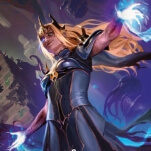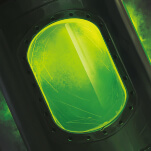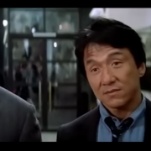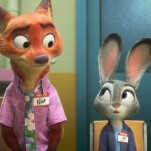Each week, Big Issues focuses on a newly released comic-book issue of significance. This week, it’s Aquaman #31. Written by Jeff Parker (Batman ’66, Flash Gordon) with art by Paul Pelletier (The Incredible Hulks, Fear Itself: The Fearless) and Alvaro Martinez (Ultimate Comics X-Men) and colors by Rain Beredo (New Avengers, Dark Avengers), this issue showcases Aquaman’s immense potential as a character by balancing thrilling superhero elements with surprisingly relevant political commentary.
Jeff Parker is one of the most skilled writers in comics when it comes to understanding the fundamental qualities that make certain characters appealing. At Marvel he pulled five Golden Age superheroes out of limbo to create the delightfully pulpy Agents Of Atlas and turned Red Hulk and Red She-Hulk into legitimately gripping action titles; his current work on Batman ’66 and Flash Gordon displays a talent for maintaining the flavor of classic properties while updating them for a more contemporary storytelling sensibility. Parker is a smart creator with ambitious ideas, and that’s the exact type of writer that Aquaman needs.
Geoff Johns worked hard to make Aquaman a major player in the DC universe, directly tackling public opinion of the character by making him as much of a badass as possible. He also went out of his way to give Arthur Curry a substantial supporting cast, doing strong work fleshing out the personality of Arthur’s girlfriend, Mera, while introducing a new team of superheroes called The Others, who helped Arthur with his ongoing troubles. Johns’ run lost some steam as it ventured into exceedingly gloomy territory, but it succeeded in making Aquaman less of a joke.
Johns set out with something to prove in his Aquaman run, but there’s none of that defensiveness in Parker’s interpretation. In his Comics Panel review of Parker’s first issue on Aquaman, Matt D. Wilson writes, “Proving that a character isn’t lame by putting him in the midst of a simple, exciting, well-told narrative doesn’t seem like a novel concept, but it feels like one here,” and Arthur has only become more captivating as Parker’s narrative becomes more layered. An especially notable chapter featured Mera joining Arthur for his high school reunion, an issue that made Aquaman more relatable than he has been in years.
Wilson’s review favorably compares that first issue to Greg Pak and Aaron Kuder’s early issues of Action Comics—which similarly tap into the core of its superhero lead by having him smack around giant monsters—and the two books have more in common than just bombastic action. They both feature complex female co-stars, the tricky politics of foreign fantasy kingdoms, and shady organizations working in the background to make things especially difficult for the superheroes—story elements that are shared by Swamp Thing, the title that crosses over with this week’s Aquaman #31.
Despite these similarities, none of these books feel like they’re covering the same territory, thanks to the efforts of the creative teams in setting a distinct tone. Action Comics emphasizes the friendship between Clark Kent and Lana Lang (at least before it became trapped in the current “Doomed” crossover). Swamp Thing focuses on the horrific aspects of the superhero world. And Aquaman offers political intrigue, using the Atlantean setting to explore contemporary social issues in a fantastic underwater environment. The crossover between Swamp Thing and Aquaman works particularly well because the scope of each title is huge; the former covers all plant life on Earth, the latter covers all the aquatic life, and the two realms naturally overlap.
Aquaman #31 features an exciting brawl between Aquaman, Swamp Thing, and Y’Wara (of The Others) in the Louisiana bayou, exquisitely rendered by penciller Paul Pelletier, inker Sean Parsons, and colorist Rain Beredo, but the most riveting part of Parker’s story is the subplot following Mera as she investigates the Atlantean revolutionaries that tried to assassinate her in the last issue. It’s a mission that gives Parker the opportunity to comment on conservative, militant factions of the American South and Midwest when Mera ventures into the Underrealm Of Atlantis, where the citizens are described as “traditional,” “provincial,” “paranoid,” and “xenophobic.”
Elder Koah tells Mera that some think these people are the epitome of what Atlanteans should be, and the ongoing conflict between the supporters of the old guard and Arthur’s new administration helps ground the story in ideas that are more substantial than the standard hero-versus-villain superhero plot. Aquaman doesn’t just protect his people, he rules over them, and that introduces a whole other set of responsibilities. Those duties largely fall on Mera’s shoulders, and seeing her take control of Atlantis on her own has been a highlight of Parker’s run. Mera keeps the attempt on her life a secret from Arthur so she can deal with the problem on her own, and it gives Parker the opportunity to showcase Mera’s strength as an individual.
The Swamp Thing plot follows the typical superhero team-up structure of a misunderstanding that leads to a fight before clarification brings the heroes together, but the creative team makes the action so entertaining that it’s easy to excuse the conventions. Paul Pelletier has become the spiritual successor to Alan Davis over the years, delivering slick, detailed artwork with dynamic, powerful action and an impressive sense of scope, and Arthur and Y’Wara’s battle with Swamp Thing puts all those skills to use.
A full-page spread of a quartet of alligators ripping into Swamp Thing hits with incredible force, and things only intensify when the Green’s avatar shows off his full power. After getting ripped apart in the water, Swamp Thing puts an end to this farce by growing to a size so large that he traps Arthur and Y’Wara between his ribs, an astounding display of the character’s might that takes advantage of how different Swamp Thing is from the usual superhero. There’s something about Swamp Thing that brings out exceptional work in the artists that tackle him (his masterful design is a big part of that), and his presence in this issue allows Pelletier to go for more atmospheric visuals than usual. That emphasis on mood works especially well for the issue’s cliffhanger, helping to push the book into creepier sci-fi territory.
Warner Bros. is trying to replicate the success of Marvel’s film franchise by building a Justice League movie as quickly as possible, and Aquaman could easily be the company’s answer to the Thor films, a mystical fantasy in a foreign kingdom starring a hunky blond guy. Following the cues of Parker’s run, an Aquaman film could be the superhero version of Pacific Rim, pitting a king and his underwater country against giant monsters from the depths of the sea that threaten all life on Earth. At the end of Mera’s scene, there’s a panel of the Underrealm revolutionaries standing on giant crabs poised to attack, a striking image by penciller Alvaro Martinez and inker Raul Fernandez that is just begging to be put on the screen.
Aquaman gets flak for being able to talk to fish, but there’s a whole world of terrifying underwater creatures for him to command. Picture this: a Captain Phillips-style ocean hijacking, complete with shaky-cam, is foiled when a whale crashes into the side of a ship, sending pirates into shark-infested waters. The people on the ship shield their eyes as swarms of flying fish cloud their vision; as the pirate ringleader pulls his hands away from his face, Aquaman’s fist collides with his jaw. Then he dives back in the water and torpedoes to the majestic kingdom where he is king.
Aquaman is an easy target for ridicule, but it wouldn’t take much for Warner Bros. to change public opinion. It just needs to have faith in the character’s potential and emphasize the elements that have made him an important part of DC’s stable of heroes. Jeff Parker and his art team have a firm understanding of Aquaman’s appeal and are using that knowledge to create the exciting adventure series the character deserves, delivering plenty of superhero spectacle without skimping on substance.







































